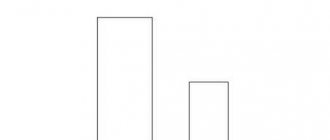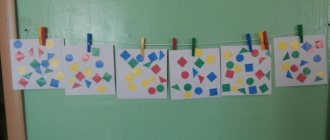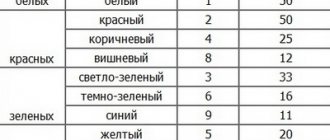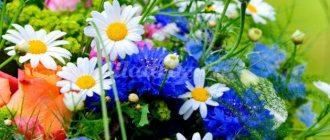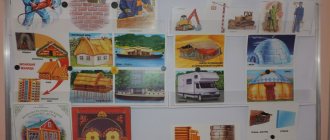Lesson summary with Cuisenaire rods
“Let’s build a nesting doll’s house”
(Middle group)
Target. To consolidate children's ideas about shape (triangular, square, rectangular), length (longest, shorter, shortest), counting (within 5); practice their orientation in space (to the left, to the right, below, above, in the middle) and naming the colors of the sticks (orange, white, purple and others).
Material. A set of colored sticks and one nesting doll for each child.
Organization. Children sit on the floor in a semicircle, with the teacher in the middle. Each of the children has a small matryoshka doll,
Progress of the lesson
- Let's build houses for the nesting dolls from colored sticks. Take four orange sticks and arrange them to form a square. The walls are ready. And use two blue sticks to build a roof. What shape will the roof of the house be? (Answers from several children.)
What else does a house have besides walls and a roof?
(Window, door, pipe.)
Take two pink sticks and make a window, from two yellow sticks - a door, from one red stick - a pipe.
What's coming out of the pipe? (Smoke.)
What sticks will you use to make smoke?
How many sticks will you take for this? What shape did the window, door, pipe turn out to be? (Children's answers.)
You can invite the matryoshka doll into the house.
But how will she get in? What needs to be added to the house for the nesting doll to fit into it? (Ladder.)
Make a ladder using white, blue and yellow sticks.
What color are the sticks at the bottom (top, middle)? Climb the stairs with the nesting doll, naming the color of each step. Now come down. Place the nesting doll on the longest stick-step (in short, the shortest one). What color is the stick in the middle? (Children's answers.)
Take three purple sticks and place them on the left side of the house, and four sticks of the same color on the right. (Children do.)
There is a fence near the house. How tall are the fence sticks? What color are they?
Now let’s plant a tree near the house. We will make the trunk from one green stick, and the branches from blue sticks. How many sticks were needed for the trunk, and how many for the branches? (Ask several children.)
How will the nesting dolls visit each other? We need paths. Connect the houses with paths. Take whatever sticks you want for the paths, but so that the path
it turned out to be the same color. (Ask the children what size and color sticks they used to build the paths, and how many of them were needed.)
I think all the nesting dolls will happily live in their beautiful houses and visit each other.
Lesson summary with Cuisenaire rods
"Trains"
(Middle group)
Target. Exercise children in quantitative and ordinal counting, spatial orientation, ordering sticks by length, mastering the composition of numbers, distinguishing numbers and colors; develop the ability to think, reason, prove, independently formulate questions and answer them.
Material. Flannelgraph, flat version of sticks and animal silhouettes for flannelgraph; a set of colored sticks for each child, numbers.
Progress of the lesson
— Guys, do you like to travel? (Answers.)
Then guess what we'll take on our trip today:
There is a ladder in the field, The house is running up the stairs.
(Train)
How did you guess that it was a train? (Answers.)
Well, let's get our trains ready and off we go...
Make a train of stick cars - from longest to shortest. Made up? Go! And along the way we’ll play “questions and answers.” I ask one question, and one of you asks the other. (Children formulate questions by analogy.)
How many cars does the train have in total? What is the order of the brown carriage? What color car is the sixth one? What order is the carriage between orange and brown? Find the car that is next to the yellow one, but not the red one. What color is the carriage to the left (to the right) of burgundy? (Children's answers.)
The funny carriages run, run, run.
Their round wheels go on and on and on.
List the colors of the cars in order from left to right. And now it’s the other way around—from right to left. (Children's answers.)
I will name the size of the carriage, and you show it: the longest, shorter, even shorter... who will continue? And now it’s the other way around: the shortest, longer, even longer. (One of the children continues to name and show.)
Number the cars of your train. What color is the ninth carriage? What size is the first (last) car? (Answers.)
There are passengers on our train - here they are. (Show white stick).
How many passengers are in the last carriage?
(Place white sticks along the length of the “car” and count them.)
What will your question be?
(Ask several children.)
How many passengers will fit in the ninth and tenth cars?
Prove it. And in the eighth and seventh? How did you find out? In what order are the five passengers traveling in the carriage? (Answers.)
Guys, an oncoming train is moving along the railway. (Make a train of four cars on a flannelgraph.)
The only passengers in it are animals: an elephant, a cow, a cat, a dog.
There is also a mouse on this train, but it is hidden and cannot be seen. Guess which carriage the mouse is in, if we know that he is not traveling with a dog or an elephant? (The mouse rides with the cow, since the cat can eat the mouse.)
It's nice to ride on a passenger train, isn't it? But there are also freight trains, and they are very necessary. Make a freight train out of sticks of whatever color you want. (Ask 2
-3
children, what color sticks did they use to make their “train” and how many “cars” are there in it?)
We have a single-seater load
(show the white stick),
a double-seater
(pink),
a three-seater, etc. This load must be distributed according to the wagons are fully loaded, but in different ways.
, start asking what kind of cargo is in the first car, how the second car was loaded, etc.)
Our trains arrived at the station on schedule. But there is no station building, it needs to be built, but only from those sticks that are indicated by numbers on the cards. (Give the children cards with numbers, according to them, select the sticks from which the building is created
).
After visiting the buildings, children are asked to stand in a circle. The teacher throws a ball to each of the children and asks questions: “What was interesting in the lesson? What did you like most? What was the most difficult task? And the easiest? Do you think you did a good job? Why did you decide this? What would you praise yourself for?
Appendix 3.
Mathematics for preschoolers on Cuisenaire sticks. Where to start getting acquainted with chopsticks?
We offer you an overview of the exercises recorded at the webinar by the author of educational games, Bella Borisovna Finkelshtein.
Believe it or not, all the math concepts a child learns from 2nd through Pre-K can be illustrated using colored counting sticks.
Let's show this in basic game exercises.
Simple math concepts:
One and many. Many and one.
Where is one? Where is there a lot?
Comparison of sets. More less; longer is shorter.
We show the concept of equality on sticks.
Concept of numbers.
Each stick has a name, it is written
is expressed in numbers. (Cardboard numbers and signs are included with the game.)
Let's sign the blue stick, and the pink one... What's the name of the red stick, let's find a number for it!
Composition of numbers from units. How many units are in a number, so is the number.
Children's research activity: determine how many units are in a pink stick, in a black stick. The length of each stick can be indicated by a number, and when comparing, use the signs ><=
We form the idea of more, less. How much more (less). Equalization.
| 3 is more than 2 by 1 | 6 is less than 7 by 1 |
Natural series. Construction of natural series.
First stage: we build a row up to 5, the second stage - from 5 to 10. We build rows in two planes - vertical and horizontal.
Let's build a ladder! (What's the next step? Let's count! (one, two, three....)
Another research work is to prove that each subsequent number is 1 more or 1 less than the previous one.
Sticks can be combined into families:
| White family: | Black family: |
| Red family: | Blue family: |
| Yellow family: | |
| It may be noted that some numbers are included in several families. As you guessed, families combine numbers that are multiples of 2,3,5 and prime numbers. One and seven - families - singles. |
7. Composition of a number from two smaller ones.
A very effective exercise for consolidating the composition of a number from two smaller ones.
Children will not only remember the composition, but also choose the number themselves and feel the composition tactilely.
Example exercises:
We will weave rugs.
Let's weave a carpet. Let's fold the number 7 carpet:
Or we'll assemble a runway for an airplane...
It is useful to write down (code) your rug using numbers. Decoding is also interesting.
Solution of examples:
We supplement the solution of the examples with numbers and signs.
| Addition. | Subtraction: |
Drawing up problems based on models.
Children are happy to come up with problems using the proposed models for addition and subtraction.
7 sparrows were sitting on a branch, 2 more sparrows flew in, how many sparrows are sitting on the branch? There were 7 cars in the parking lot, 2 more parked.... etc. Children's imagination is limitless. What will your task be about?
Prepare to understand the operations of multiplication and division.
| Multiplication: How many rows? How many in one row? How much in total? | Division: Two is the measure of an object. |
11. Going through ten.
In many languages, the numbers of the second ten sound the same: five times ten. We take Ten (twenty) and put five on it. That makes fifteen.
Let's make thirteen, seventeen from sticks!
Names of numbers that are multiples of ten. Fifty - five tens.
What does thirty look like? or eighty?
We saw the possibilities of using sticks to solve arithmetic problems.
Consider the use of sticks in geometry.
Square.
Research work: prove that all sides of a square are equal. (Take a measurement and apply it to each side).
Rectangle. We prove the equality of opposite sides.
Triangle. We count the number of angles and sides.
Polygons, angles: right, acute, obtuse.
All of these exercises can be gradually introduced as part of a lesson (GCD).
For use in classes, you will need one box of colored Cuisenaire counting sticks for 2-3 people.
And, of course, in the educational process we use games and manuals that allow you to systematically work with colored Cuisenaire counting sticks.
| Younger age | Average age | Older age |
Card index of games and exercises with sticks by J. Cuisenaire
Game "Drying towels"
Target.
Teach children to compare objects by length; find similarities between objects; classify objects by length and color, indicate the results of comparison in words (longer - shorter, equal in length). Material. Colored counting sticks: 1 brown, 5 yellow, 5 red (for each child).
Description: There are chopsticks of two colors on the tray.
Tasks
– Set aside the same-length sticks. What color are they?
– What should you do to find out which sticks are bigger? (Put sticks of one color under sticks of another color.)
– How many long (short) sticks? (Many, as much, as much, equally.)
– Place the brown stick in front of you. (Show.) This is a rope. Yellow and red sticks are “towels”. Let's hang the “towels” on a line to dry. First hang a long, then a short, then a long “towel”. What kind of “towel” should you hang now? (A short.)
Hang up all the “towels.” Touching the “towel” with your finger, name its color: yellow, red, yellow...
Questions
– How many yellow “towels”? (A lot of.)
– How many red “towels”? (A lot of.)
– What color of “towels” are there more (less)? How can you find out? What needs to be done for this? (Attach the yellow “towel” to the red “towel.”)
– So which “towels” are there more (less)? (Equally, equally, as many yellows as there are reds.)
Game "Numbers 1 and 2"
Target. Teach children to compare objects by length and use words to indicate the result of the comparison. Introduce the formation of the number 2, the numbers 1 and 2.
Material. For the teacher: magnetic board; 2 white squares 10×10; pink stripe 20 x
10 cm;
numbers 1 and 2. For children: colored counting sticks - 3 white and 3 pink; numbers 1 and 2; card. Description: The teacher invites the children to show him a white cube and asks: “How many white cubes did you show?
What number can be used to denote this number? The teacher puts the number 1 on the board under the white square.
Children put the number 1 under the white cube and repeat: “One cube – number one!”
The teacher focuses the children’s attention: “The white cube is the shortest “stick” in our set. What is it equal to? (To one.)
What number does it represent?
(One.)
Show the pink stick.
Place it under the white stick so that the edge matches on one side. Which stick is longer? (Pink.)
The teacher demonstrates this stage of work on the board.
“Place another white cube next to the white one. (Demonstrates on the board.) Let's count how many white cubes are in the row. (One, two, just two cubes.)
Which sticks are longer, one pink or two white?
(Equal, equal in length.)
The pink stick represents the number two.
(Shows and names the number 2, puts it next to the number 1.) Why do we put the number two next to the pink stick? (Because it contains two white sticks.)
Remove the white cube on the right and replace it with a pink stick.
It turned out to be a ladder. How many steps does it have? (One.)
How many rows?
(Two.)
How many sticks are in the second row, if you count from bottom to top?
(One, two.)
Place two white cubes next to the pink stick.”

